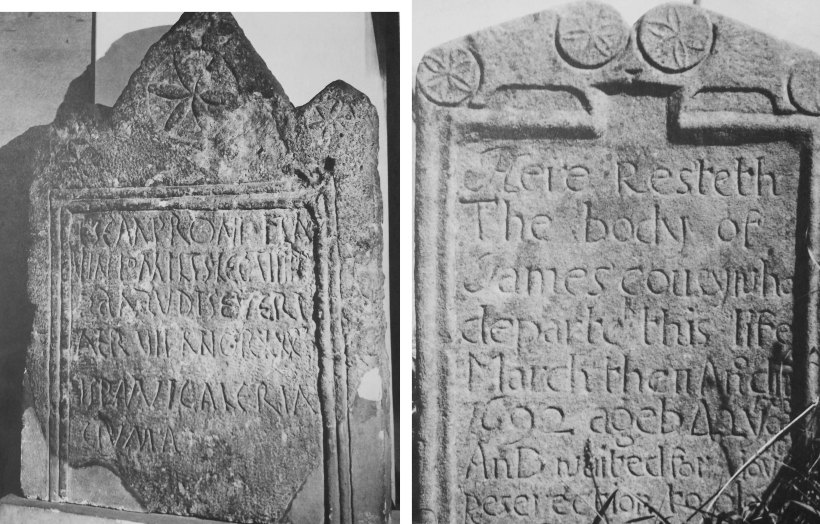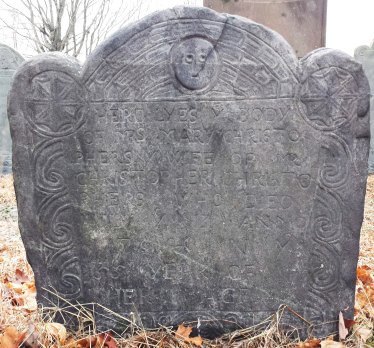That title should also have the word ‘mortuary’ in it somewhere, but you probably guessed that’s where I’m going with this! Today I wanted to talk about above-ground material culture relating to historic burials. More specifically, about the classic gravestones of colonial New England and symbology that appears with some regularity throughout the region that display an iteration of several compass-drawn symbol often found in medieval churches and on items of furniture in the British Isles.

‘Ye Antientist Burial Ground’, 1652~, New London, Connecticut. Photo by author, 2015

Classic hexfoil design. Image from: medieval-graffiti.blogspot.ca
It’s always exciting: You’re exploring an old building, when suddenly a pattern catches your eye, hiding in the shadows of a pillar, on the side of a church pew, or maybe along the edge of a low roof beam. Historically we seem to have a desire to carve, among other things, our own names into anything we can, along with pictures, symbols, and dates. Quite a lot of the surviving graffiti from the medieval period in the UK can be seen in the fabric of historic churches, from ritual protection marks, to faces, letters, and boats. A common design, supposedly carved with a compass (but more likely with more common scissors, see Champion 2015), is the hexfoil, sometimes also called the daisy wheel or the witch mark.
The hexfoil is very prevalent as a medieval graffiti design, potentially offering protection from something or for someone, dependent upon where the symbol was placed. It’s often found on furniture, such as a bedframe at Lindisfarne Castle in the northeast of England, or on the edge of an Irish sailor’s chest right here at the Rooms in St. John’s, Newfoundland, or carved right into the building itself! While no one is really sure of the origins of this symbol, and indeed it appears in several cultural contexts, we do know it was very popular in the Roman period, and begins appearing in the British Isles around/after the Romano-British period. In churches, the symbol can often be found on/near baptismal fonts (and on the walls, the pews, the chests… etc). They would have been placed as a protection measure against evil, and there are many different versions of similar designs, some incorporating more complicated design elements, and some simply following the circular idea such as the ‘pin-wheel’ design pictured later in this post. It appeared to have been a very wide-spread belief used to protect people, and was more associated with living spaces than death-spaces. That being said, this is a blog about death and burial, so lets focus on that part!

Left: Romano-British gravestone displaying hexfoils. Right: Gravestone from Frampton on Severn, England, dating to 1692. This is a rare example of post-medieval hexfoils on a gravestone that has not been reused. (Images from Ludwig 1966: 272-273)
In England, the mass use of inscribed stone (what we would think of as a ‘proper’ gravestone) to mark individual graves was not commonplace until the 1600s (Bartram 1978), and gravestones and memorials were rare prior to the 12th-century (Houlbrooke 1998, 360-361). While there are some examples from Scotland and the Isle of Man (Kermode 1907) of cross stones and gravestones with hexfoil designs, they are all from the medieval period. In fact, the above image of the 1692 stone is the only example I have found of a gravestone displaying hexfoils in England that isn’t an older carved example being reused as a gravestone later on.
These ‘folk’ symbols start to become less frequent in England around the late 16th into the 17th century, partially as a result of the Reformation attempting to squash ‘superstitious’ medieval Catholic practices, but can still be seen hidden in houses from that period. The use of protective marks like the hexfoil moved across the pond into North America and became fossilized in colonial New England’s emerging gravestone carving culture, in a very visible way.
So we go from few examples of the design in 17th-century England to 20 hexfoils on one gravestone (thanks, Mr. Wheeler!) in colonial America! There has been a lot of work done on the carvers and their traditions on the east coast of North America, and Ludwig (1966) does mention the hexfoil pattern briefly in his text on gravestone decoration. Hexfoils, however, aren’t the only examples of these protective markings that appear on 17th- and 18th-century gravestones in colonial settlements!
Here we can see that the pinwheel design was popular for nearly 100 years throughout the region (I had to cherry-pick these examples!), with the wheels ‘turning’ in both directions. This wheel is less common than the hexfoil in medieval graffiti, but seems to have taken on a life of its own as an aspect of gravestone decoration.

1676 gravestone, Hartshorne tradition, New London, CT. Photo by author, 2015.
Finally, here is another design which is very similar to the compass-drawn hexfoils when additional detailing is added to them, resulting in an almost spider web-like pattern. The most common placement for these sort of protection markings on New England gravestones is on the finials, flaking either side of the lunette (the top, central design), and over the inscription. This placement, clearly, can vary wildly between carvers and clients.
But why were they doing this? In short, it is most likely that the marks were being used primarily for their original purpose, that of protecting someone… in this case that someone just happens to be dead. People who were immigrating to North America began using it so regularly on the stones that marked their dead that this continued as a new tradition throughout the region for at least the next 100 years. Sometimes marks like these are called witch marks which could potentially account for some of their continued popularity in the New England area.
As I mentioned before, these symbols weren’t just used in the British Isles and New England. Hex foils can be seen on Pennsylvania Dutch barns and Scandinavian butter / cheese moulds, for instance At the moment I am unfamiliar of gravestones in North America dating from the 19th-century that display protective symbols, but if anyone reading this post has a photo they would like to share, I’d love to hear from you on the subject!
Cited:
Bartram, A. 1978. Tombstone Lettering in the British Isles. Lund Humphries: London.
Champion, M. 2015. Medieval Graffiti: The Lost Voices of England’s Churches. Ebury Press: England.
Houlbrooke, R. 1998. Death, Religion, and the Family in England, 1480-1750. Oxford: Clarendon Press.
Kermode, P. M. C. 1907. Manx Crosses, or The Inscribed and Sculptural Monuments of the Isle of Man from about the the end of the Fifth to the beginning of the Thirteenth Century. Bemrose & Sons. Ltd.: London. Available online at: http://www.isle-of-man.com/manxnotebook/fulltext/mc1907/index.htm
Slater, J. A. 1987. The Colonial Burying Grounds of Eastern Connecticut and the Men Who Made Them. Archon Books: Hamden, Connecticut.




Pingback: Inscribed Letters & Protective Marks – The Case of the W | Spade & the Grave
Pingback: Hexed - The Collation
February 28, 2019 at 7:27 pm
I have one on a old log stage coach stop 1808 door jam
LikeLike
February 28, 2019 at 7:30 pm
That sounds amazing, do you have a photo of it?
LikeLike
February 28, 2019 at 7:35 pm
Yes , how can I send them? The actual building is still where it was built
LikeLike
February 28, 2019 at 7:53 pm
If you send me a comment on the ‘contact me’ page, I can reply with my email and they could be sent to that. I would be very interested to see!
LikeLike
Pingback: Protect the Grave: The hexfoil in an early mortuary context | Spade & the Grave
March 20, 2021 at 12:50 pm
Really interesting stuff, what do you think the significance is of the round face with wings at the top? Is it an angel or winged solar disk? Strange
LikeLike
April 10, 2021 at 1:04 pm
Hi Ethan, thanks for your comment!
The little round face with wings could be two things, either a skull or a human face / cherub. The skull with wings is commonly called the ‘death’s head’ and is a memento mori, or symbol that reminds the viewer that they will also die. The human face or cherub with wings is also called a ‘soul effigy’ and is said to signify the deceased’s soul going to heaven, or possibly an angelic being.
LikeLike